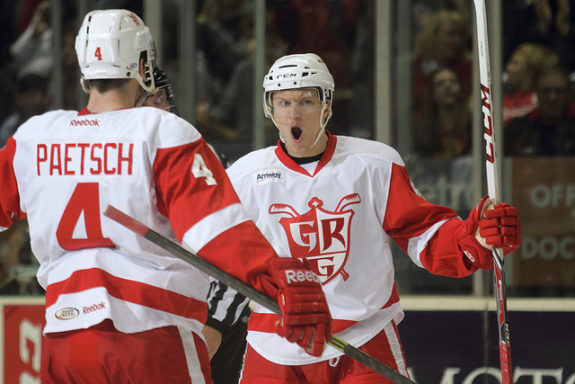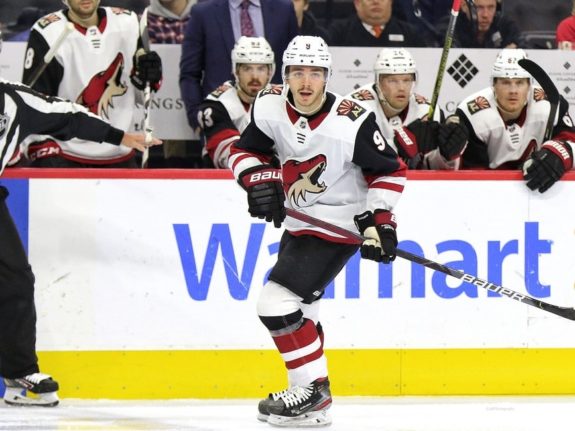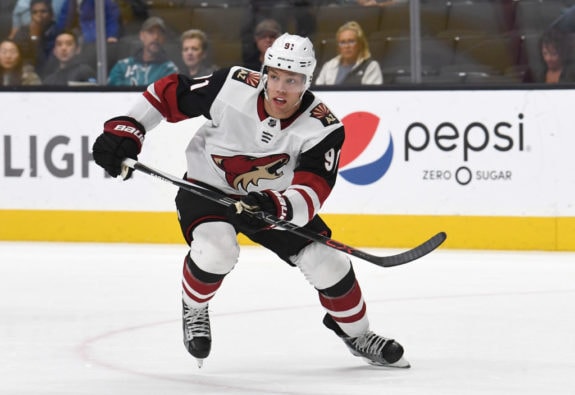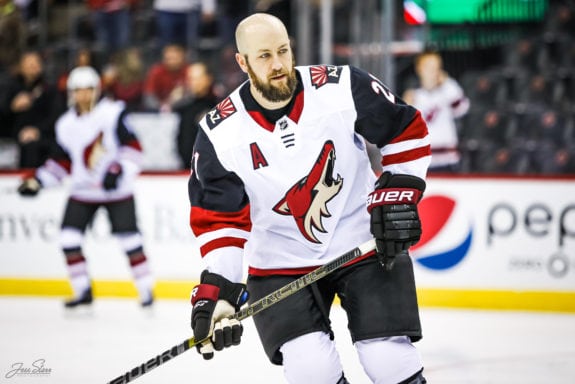It seems like just yesterday that we were playing around with the CapFriendly Expansion Draft simulator in anticipation of the Vegas Golden Knights entering the National Hockey League during the 2017 offseason, but yet another such occurrence is right around the corner. The yet-to-be-named Seattle franchise, which will begin play in 2021-22, will draft its players in mid-to-late June of 2021, which is less than 15 months from now.

The Arizona Coyotes had a relatively easy time during the expansion process the first time around – they had a young roster with many exempt players, and, as such, were not in danger of losing a key player to then-Vegas general manager George McPhee. This time, though, there will likely be some tough decisions to be made.
Recapping the 2017 Expansion
In 2017, the Coyotes had just wrapped up their third consecutive losing season – the roster was relatively weak, and, therefore, the list of key players that needed to be protected was short. At the time, teams had the option of protecting seven forwards, three defensemen, and a goalie, or, alternatively, a combination of eight skaters plus a netminder.
Last go-around, the Coyotes chose the latter option, protecting eight skaters. Defensemen Oliver Ekman-Larsson, Alex Goligoski, Connor Murphy, and Luke Schenn were on the team’s protected list, as were forwards Nick Cousins, Anthony Duclair, Jordan Martinook, and Tobias Rieder. Goaltender Chad Johnson, acquired as part of the Mike Smith trade on June 17, 2017, was the protected goalie.

As for the list of available players, expansion draft rules stated that teams must expose at least two forwards and one defenseman who had played at least 40 games in the previous season (2016-17) or a total of 70 games in the last two seasons combined, along with one goaltender who was under contract for the upcoming 2017-18 season. Ultimately, Jamie McGinn and Brad Richardson satisfied the exposure requirements for forwards, Kevin Connauton was the club’s available defenseman, and Louis Domingue was the goaltender that was left unprotected.
Aside from those four, the Coyotes’ list of available players was short on guys with long-term value to an NHL team. In fact, no other players under contract past 2017 were available to the Golden Knights. Only fringe restricted free agents like Alexander Burmistrov, Josh Jooris, Teemu Pulkkinen, Tyler Gaudet, Peter Holland, and others were available, as were unrestricted-free-agents-to-be like Radim Vrbata, Jarred Tinordi, Zbynek Michalek, and Jamie McBain.

In the end, Vegas’ choice was Pulkkinen, who was acquired from the Minnesota Wild at the 2017 deadline. Pulkkinen played just four games in Arizona that year, and hasn’t played an NHL game since, so this loss wasn’t a big one for the Coyotes when compared to the players that other teams lost (or voluntarily surrendered).
Looking Ahead to 2021
The Seattle expansion draft rules will be the same as they were for the Golden Knights, but the one difference is that it’s probable the Coyotes will lose an NHL player this time.
Current pieces of the team’s long-term plans, like Nick Schmaltz, Darcy Kuemper, Antti Raanta, Jason Demers, and Niklas Hjalmarsson, were not yet on the roster at the time of the previous expansion draft in June 2017. Others, like Clayton Keller, Jakob Chychrun, Christian Dvorak, and Lawson Crouse, were exempt from selection as first and second-year players. These players, if they’re still on the roster in 2021, will all need to be protected.

Before we go any further, though, we can throw out Hjalmarsson and Demers’ names. Both players are slated to become unrestricted free agents (UFA) in 2021, so, unless they sign extensions before then, which is unlikely since general manager John Chayka will do his best to maneuver around the expansion draft rules, they won’t need to be protected. The case is the same for Raanta – he’s also a 2021 free agent, so he won’t need to be protected.
If Seattle selects a UFA in the expansion draft and they’re unwilling to make the trip to the Pacific Northwest, the player can just wait until July 1 and return to their pre-expansion club when free agency begins. Seattle will not waste picks on players who can leave the organization two weeks after the expansion draft – they’ll want either an NHLer to fill out the roster or use as trade bait, or a young player with a year or two of remaining team control.
This leaves us with Kuemper, Chychrun, Keller, Dvorak, Crouse, and Schmaltz who either weren’t on the roster or were exempt from selection in 2017, but will need to be protected this time around. That’s five skaters already, and we’ve used up our goaltender spot as well.
Coyotes’ No-Movement Clauses
Let’s also add Ekman-Larsson and Phil Kessel to the list. Both players have no-movement clauses (NMCs) in their contracts, and, by rule, these players must be protected, unless they agree to waive their NMCs. We saw this happen with Marc-Andre Fleury in 2017, who waived his NMC to leave the Pittsburgh Penguins and join Vegas, but we’re doubtful that we’d see this with either Ekman-Larsson or Kessel in 2021.
Kessel, who earns $6.8 million per season, was in the midst of a career-worst year before the COVID-19 outbreak forced the NHL to pause the 2019-20 campaign. Unless he returns to being a reliable point producer by 2021, which seems improbable since he’s already 32 years old and is showing signs of decline, there’s no way Seattle would take him, even if he was willing to waive his NMC. The same can be said for Ekman-Larsson – he carries a hefty $8.25 million cap hit until 2027 and has shown no desire to leave the Valley of the Sun since making his NHL debut with the Coyotes in 2010.

Let’s pencil both of these players in as being on the protected list. That’s seven skaters already – five forwards and two defensemen. We now have just three spots remaining for a group which includes Alex Goligoski, Derek Stepan, Carl Soderberg, Taylor Hall, Vinnie Hinostroza, and Conor Garland, along with any other current AHL players who may develop into NHLers by then.
We don’t have a crystal ball here at The Hockey Writers, but it wouldn’t be a surprise to see Tucson Roadrunners’ leading scorer and 2020 AHL All-Star Brayden Burke, All-Star defenseman Kyle Capobianco, All-Star forward Lane Pederson, or 2018 Team Canada World Juniors hero Tyler Steenbergen emerge as NHLers by next summer. Garland was just shy of his 23rd birthday when he cracked the Coyotes’ roster, so there’s still time for these players, who are all 22 or younger.
Breaking Down the Coyotes’ Roster
Before proceeding, let’s get a few more items out of the way. Recent draftees like Barrett Hayton and Victor Soderstrom will be exempt, so we don’t need to worry about losing one of them in the expansion draft. Let’s also throw out Stepan, Soderberg, and Goligoski. Soderberg will be a UFA this summer, so he won’t be on the roster unless he signs a multi-year extension. Goligoski and Stepan are 2021 free agents, and, as we discussed earlier, they won’t need to be protected.
This may be painful for Coyotes fans to hear, but let’s also assume that Hall leaves as a free agent this summer. A player of his age and skill level will undoubtedly command a huge salary on a seven or eight-year deal, and it’s been widely reported that he wants to play for a contending team. The Coyotes can be one-upped on both of these fronts in free agency – Arizona has a very slim chance of making a playoff appearance in 2020, assuming the season ever is resumed, and other teams will probably be able to offer Hall upwards of $10 million per season.

This puts the ‘Yotes in a tough spot, as they’re slated to have far less than that amount available to work with this summer, unless other moves are made to free up salary-cap space, like trading Goligoski, Raanta, or Stepan, and either buying out or trading Michael Grabner. All things considered, it seems improbable that Arizona will be able to retain Hall.
Now, let’s use a protected spot on Garland. He’s the Coyotes’ leading goalscorer this year, and has tickled the twine 35 times in 115 career games. That’s a 25-goal pace for an 82-game season – there’s no way Arizona can afford to lose their homegrown fan-favorite to Seattle next summer.
Let’s also protect current Roadrunners Burke and Capobianco. Burke, who was not drafted out of the Western Hockey League in either 2015, 2016, or 2017 despite recording a combined total of 225 points in 175 games across those three seasons, signed an entry-level deal with the Coyotes on March 1, 2018. He enjoyed a successful rookie campaign in Tucson, posting 33 points in 67 games, but has taken his play to another level in 2019-20, with 52 points in 51 games. He’s the eighth-highest scorer at the AHL level this season and was an All-Star for the Pacific Division – he could be part of the future in Arizona if he’s able to continue developing his game.

When it comes to Capobianco, there’s not really much more for him to do in Tucson. He’s been an All-Star in all three of his AHL seasons so far and has recorded at least 30 points in each of those campaigns, for a total of 99 points in 131 career games with the Roadrunners. He’s played nine contests with the Coyotes this season and hasn’t looked out of place, scoring a goal and posting a 49.3 Corsi-For percentage (CF%), which ranks fourth out of the 10 Arizona defensemen to see the ice in 2019-20. We’re projecting that he’ll earn a spot on the NHL blue line next year, so we’ll protect him in the expansion draft.
Coyotes’ Projected Protected List
Protecting Burke and Capobianco used up our last forward and defenseman spots, giving us our final 2021 protected list:
Forwards
- Clayton Keller
- Christian Dvorak
- Nick Schmaltz
- Lawson Crouse
- Phil Kessel
- Conor Garland
- Brayden Burke
Defensemen
- Oliver Ekman-Larsson
- Jakob Chychrun
- Kyle Capobianco
Goaltender
- Darcy Kuemper
The protected list is a big deal to everyone looking at who their teams can keep in 2021, but the list of players who need to be exposed to meet the NHL’s rules might be the bigger deal here. In order to remain expansion-draft compliant, the Coyotes will need to expose two forwards and a defenseman who, as we previously discussed, have played either 40 NHL games in the most recent season (which will be 2020-21) or a total of 70 NHL games across the previous two seasons (2019-20 and 2020-21), as well as a goaltender who is under contract for 2021-22.
We project that Hinostroza and Stepan will fulfill the forward portion of this requirement, while Jordan Oesterle will be the defenseman. Hinostroza and Oesterle are RFAs this summer and next summer, respectively – if the Coyotes sign each of them to an extension through 2022, they’ll be able to use both of them as expansion draft fodder, so to speak. The same is the case for Stepan – he’ll be a free agent in 2021, but if Arizona signs him to a one-year extension before then, he’ll meet the exposure requirements.

The goaltender position is where things get dicey – only Kuemper meets the exposure requirements as of this writing, so the Coyotes will need to either sign another goaltender before then, or extend the contract of either Raanta or Adin Hill in order to avoid the risk of losing Kuemper.
We project that the Coyotes will either trade Raanta before 2021 or allow him to leave as a free agent – they already have Kuemper locked up until 2022 at $4.5 million per year, so they don’t need to pay Raanta $4.25 million to be a backup. Unless Raanta takes a hometown discount to stay on with the Coyotes past 2021 as the second half of a goalie tandem with Kuemper, let’s assume that Arizona either extends Hill or brings in another backup goaltender to fulfill this requirement.
The Exposure Requirements
- F Vinnie Hinostroza
- F Derek Stepan
- D Jordan Oesterle
- G Adin Hill
There you have it – The Hockey Writers‘ official Coyotes’ protected list, as well as the four players who must be exposed to remain compliant. Who would you have protected? Would you have exposed different players? Let us know in the comments!